HR Report on Developing Individuals, Teams, and Organizations at Tesco
VerifiedAdded on 2020/10/22
|14
|4301
|96
Report
AI Summary
This report provides a detailed analysis of Tesco's HR practices, focusing on the development of individuals, teams, and the organization. It begins by outlining the professional knowledge, skills, and behaviors required of HR professionals, including conflict management and communication. A personal skill audit and professional development plan are presented, highlighting strengths, weaknesses, and areas for improvement. The report then differentiates between individual and organizational learning, emphasizing the importance of continuous learning and professional development. It explores how high-performance working contributes to employee engagement and competitive advantage within Tesco. Finally, the report examines various approaches to performance management, demonstrating how these methods support a high-performance culture and commitment. The report provides practical examples and insights into Tesco's HR strategies to foster a productive and engaged workforce.
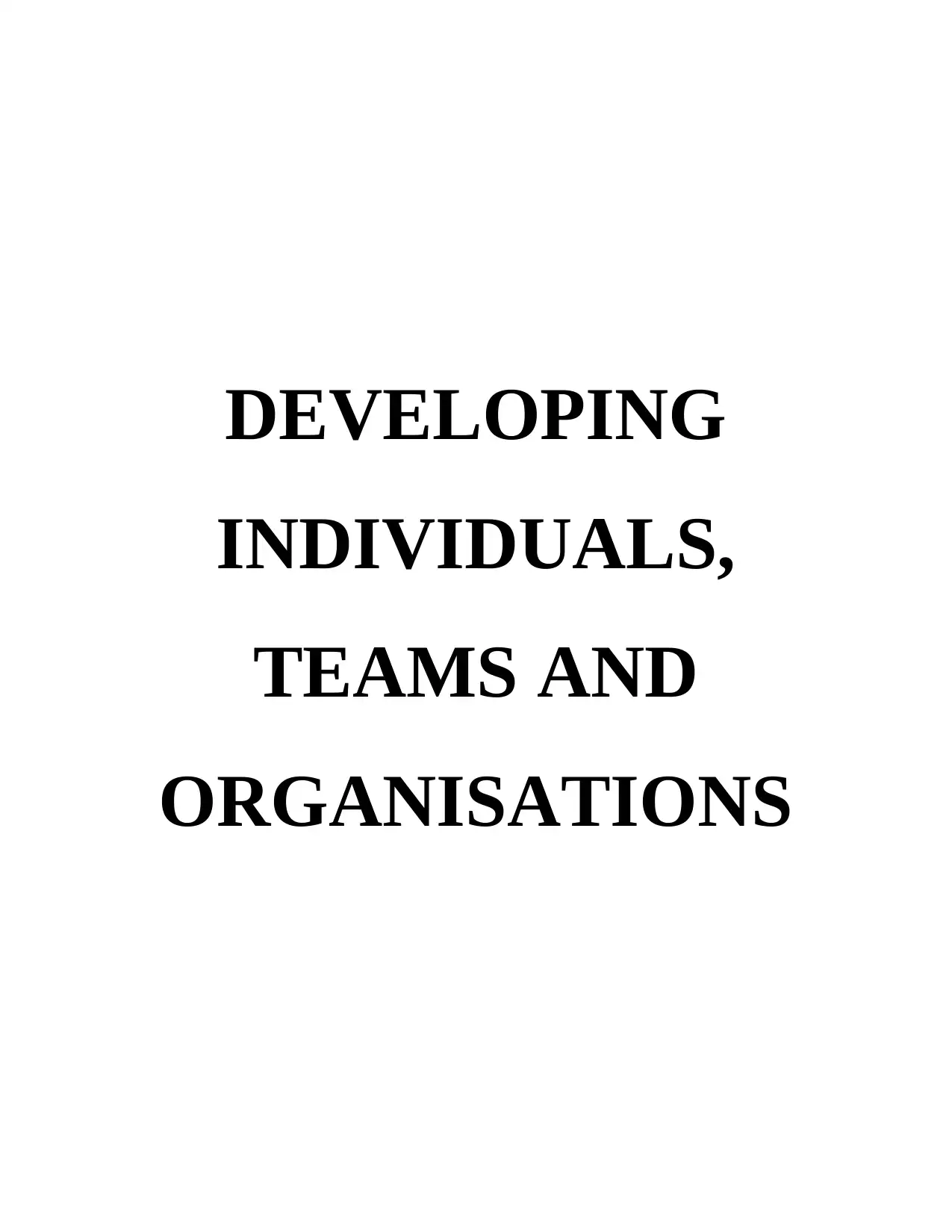
DEVELOPING
INDIVIDUALS,
TEAMS AND
ORGANISATIONS
INDIVIDUALS,
TEAMS AND
ORGANISATIONS
Paraphrase This Document
Need a fresh take? Get an instant paraphrase of this document with our AI Paraphraser
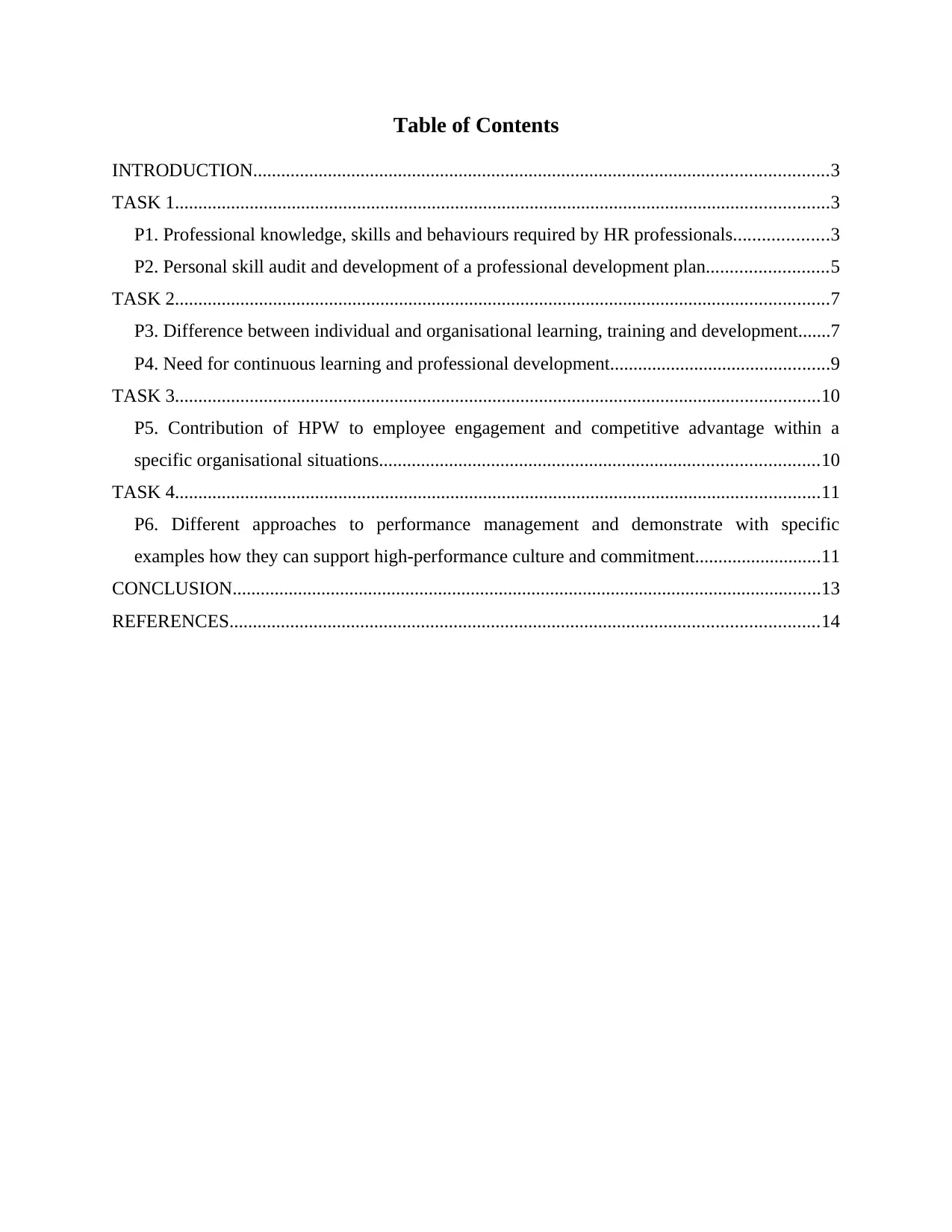
Table of Contents
INTRODUCTION...........................................................................................................................3
TASK 1............................................................................................................................................3
P1. Professional knowledge, skills and behaviours required by HR professionals....................3
P2. Personal skill audit and development of a professional development plan..........................5
TASK 2............................................................................................................................................7
P3. Difference between individual and organisational learning, training and development.......7
P4. Need for continuous learning and professional development...............................................9
TASK 3..........................................................................................................................................10
P5. Contribution of HPW to employee engagement and competitive advantage within a
specific organisational situations..............................................................................................10
TASK 4..........................................................................................................................................11
P6. Different approaches to performance management and demonstrate with specific
examples how they can support high-performance culture and commitment...........................11
CONCLUSION..............................................................................................................................13
REFERENCES..............................................................................................................................14
INTRODUCTION...........................................................................................................................3
TASK 1............................................................................................................................................3
P1. Professional knowledge, skills and behaviours required by HR professionals....................3
P2. Personal skill audit and development of a professional development plan..........................5
TASK 2............................................................................................................................................7
P3. Difference between individual and organisational learning, training and development.......7
P4. Need for continuous learning and professional development...............................................9
TASK 3..........................................................................................................................................10
P5. Contribution of HPW to employee engagement and competitive advantage within a
specific organisational situations..............................................................................................10
TASK 4..........................................................................................................................................11
P6. Different approaches to performance management and demonstrate with specific
examples how they can support high-performance culture and commitment...........................11
CONCLUSION..............................................................................................................................13
REFERENCES..............................................................................................................................14
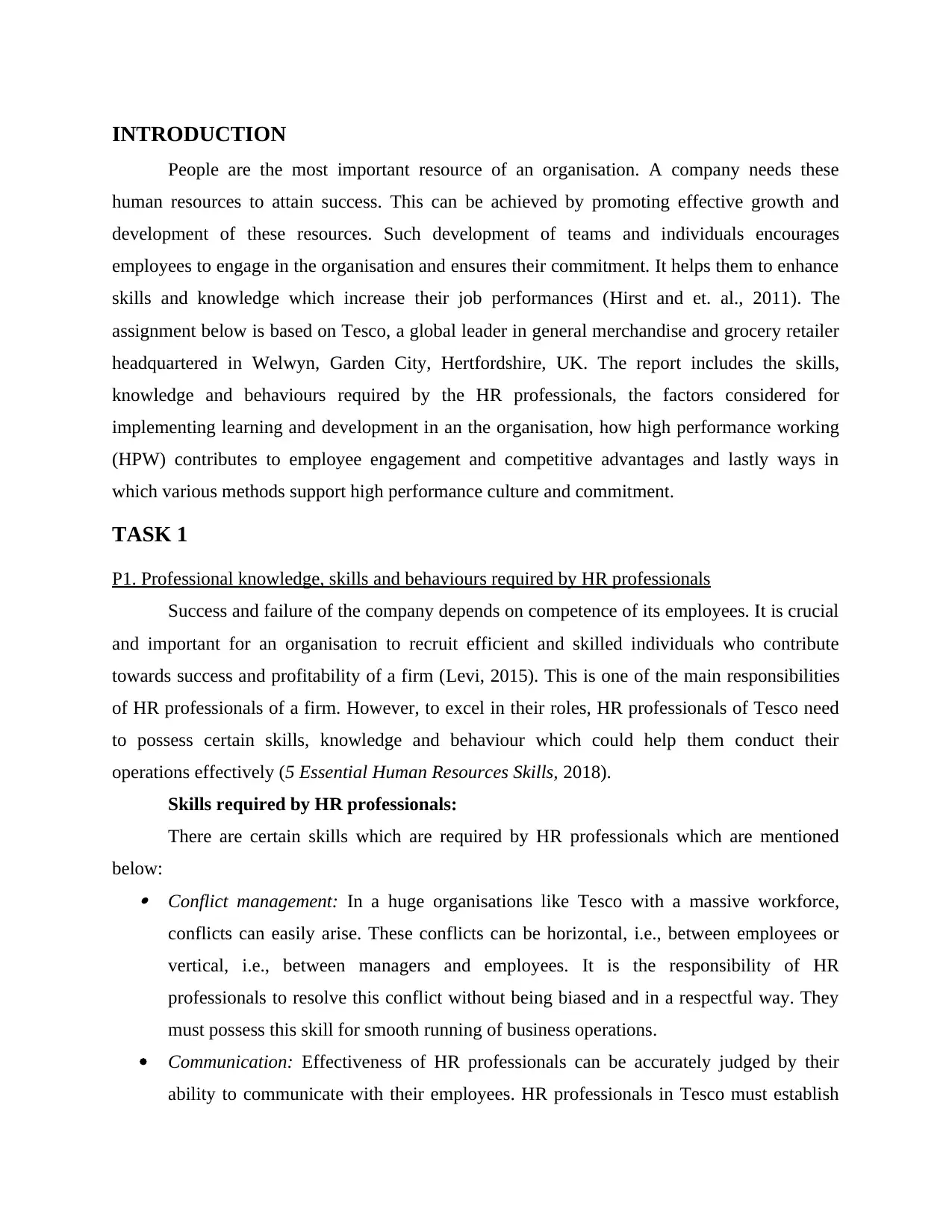
INTRODUCTION
People are the most important resource of an organisation. A company needs these
human resources to attain success. This can be achieved by promoting effective growth and
development of these resources. Such development of teams and individuals encourages
employees to engage in the organisation and ensures their commitment. It helps them to enhance
skills and knowledge which increase their job performances (Hirst and et. al., 2011). The
assignment below is based on Tesco, a global leader in general merchandise and grocery retailer
headquartered in Welwyn, Garden City, Hertfordshire, UK. The report includes the skills,
knowledge and behaviours required by the HR professionals, the factors considered for
implementing learning and development in an the organisation, how high performance working
(HPW) contributes to employee engagement and competitive advantages and lastly ways in
which various methods support high performance culture and commitment.
TASK 1
P1. Professional knowledge, skills and behaviours required by HR professionals
Success and failure of the company depends on competence of its employees. It is crucial
and important for an organisation to recruit efficient and skilled individuals who contribute
towards success and profitability of a firm (Levi, 2015). This is one of the main responsibilities
of HR professionals of a firm. However, to excel in their roles, HR professionals of Tesco need
to possess certain skills, knowledge and behaviour which could help them conduct their
operations effectively (5 Essential Human Resources Skills, 2018).
Skills required by HR professionals:
There are certain skills which are required by HR professionals which are mentioned
below: Conflict management: In a huge organisations like Tesco with a massive workforce,
conflicts can easily arise. These conflicts can be horizontal, i.e., between employees or
vertical, i.e., between managers and employees. It is the responsibility of HR
professionals to resolve this conflict without being biased and in a respectful way. They
must possess this skill for smooth running of business operations.
Communication: Effectiveness of HR professionals can be accurately judged by their
ability to communicate with their employees. HR professionals in Tesco must establish
People are the most important resource of an organisation. A company needs these
human resources to attain success. This can be achieved by promoting effective growth and
development of these resources. Such development of teams and individuals encourages
employees to engage in the organisation and ensures their commitment. It helps them to enhance
skills and knowledge which increase their job performances (Hirst and et. al., 2011). The
assignment below is based on Tesco, a global leader in general merchandise and grocery retailer
headquartered in Welwyn, Garden City, Hertfordshire, UK. The report includes the skills,
knowledge and behaviours required by the HR professionals, the factors considered for
implementing learning and development in an the organisation, how high performance working
(HPW) contributes to employee engagement and competitive advantages and lastly ways in
which various methods support high performance culture and commitment.
TASK 1
P1. Professional knowledge, skills and behaviours required by HR professionals
Success and failure of the company depends on competence of its employees. It is crucial
and important for an organisation to recruit efficient and skilled individuals who contribute
towards success and profitability of a firm (Levi, 2015). This is one of the main responsibilities
of HR professionals of a firm. However, to excel in their roles, HR professionals of Tesco need
to possess certain skills, knowledge and behaviour which could help them conduct their
operations effectively (5 Essential Human Resources Skills, 2018).
Skills required by HR professionals:
There are certain skills which are required by HR professionals which are mentioned
below: Conflict management: In a huge organisations like Tesco with a massive workforce,
conflicts can easily arise. These conflicts can be horizontal, i.e., between employees or
vertical, i.e., between managers and employees. It is the responsibility of HR
professionals to resolve this conflict without being biased and in a respectful way. They
must possess this skill for smooth running of business operations.
Communication: Effectiveness of HR professionals can be accurately judged by their
ability to communicate with their employees. HR professionals in Tesco must establish
⊘ This is a preview!⊘
Do you want full access?
Subscribe today to unlock all pages.

Trusted by 1+ million students worldwide
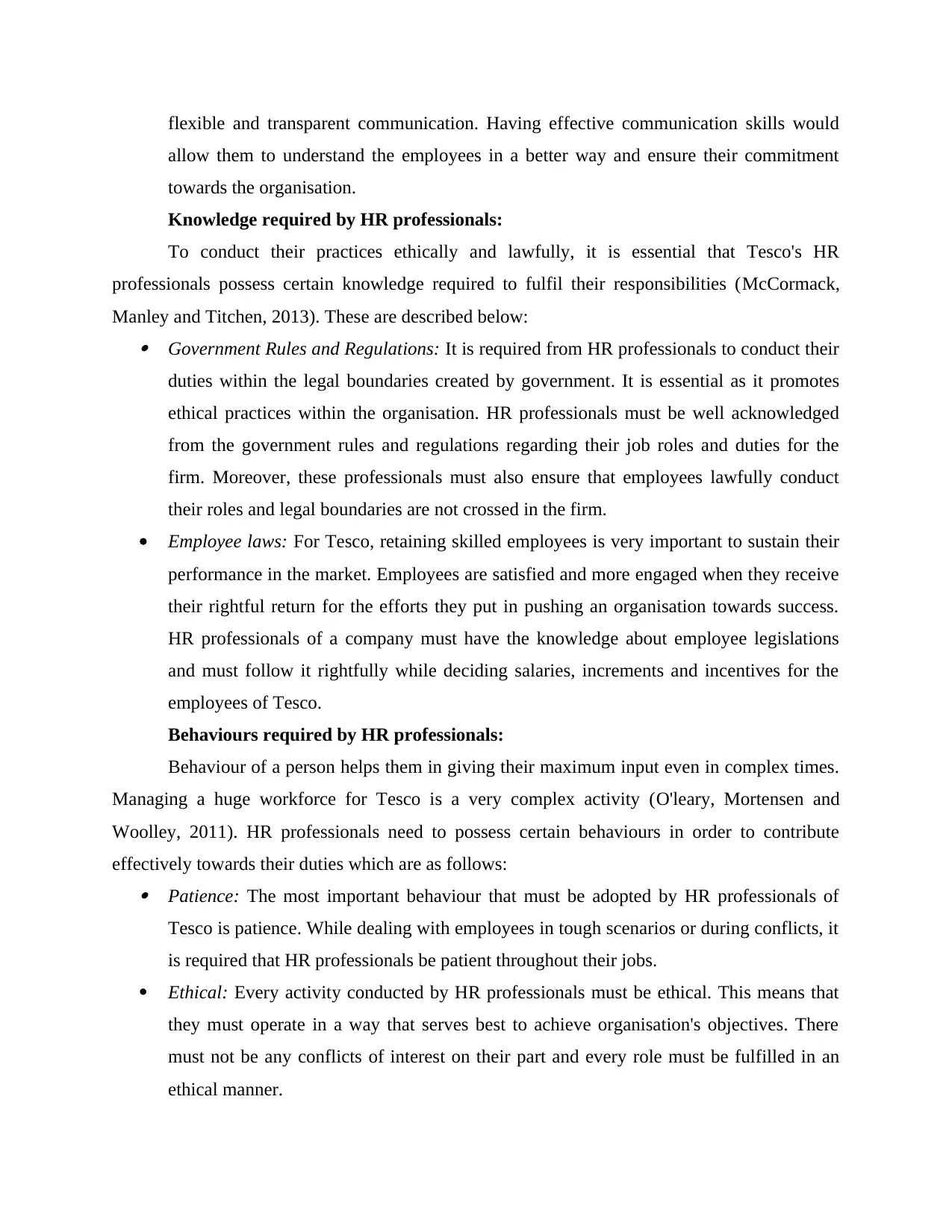
flexible and transparent communication. Having effective communication skills would
allow them to understand the employees in a better way and ensure their commitment
towards the organisation.
Knowledge required by HR professionals:
To conduct their practices ethically and lawfully, it is essential that Tesco's HR
professionals possess certain knowledge required to fulfil their responsibilities (McCormack,
Manley and Titchen, 2013). These are described below: Government Rules and Regulations: It is required from HR professionals to conduct their
duties within the legal boundaries created by government. It is essential as it promotes
ethical practices within the organisation. HR professionals must be well acknowledged
from the government rules and regulations regarding their job roles and duties for the
firm. Moreover, these professionals must also ensure that employees lawfully conduct
their roles and legal boundaries are not crossed in the firm.
Employee laws: For Tesco, retaining skilled employees is very important to sustain their
performance in the market. Employees are satisfied and more engaged when they receive
their rightful return for the efforts they put in pushing an organisation towards success.
HR professionals of a company must have the knowledge about employee legislations
and must follow it rightfully while deciding salaries, increments and incentives for the
employees of Tesco.
Behaviours required by HR professionals:
Behaviour of a person helps them in giving their maximum input even in complex times.
Managing a huge workforce for Tesco is a very complex activity (O'leary, Mortensen and
Woolley, 2011). HR professionals need to possess certain behaviours in order to contribute
effectively towards their duties which are as follows: Patience: The most important behaviour that must be adopted by HR professionals of
Tesco is patience. While dealing with employees in tough scenarios or during conflicts, it
is required that HR professionals be patient throughout their jobs.
Ethical: Every activity conducted by HR professionals must be ethical. This means that
they must operate in a way that serves best to achieve organisation's objectives. There
must not be any conflicts of interest on their part and every role must be fulfilled in an
ethical manner.
allow them to understand the employees in a better way and ensure their commitment
towards the organisation.
Knowledge required by HR professionals:
To conduct their practices ethically and lawfully, it is essential that Tesco's HR
professionals possess certain knowledge required to fulfil their responsibilities (McCormack,
Manley and Titchen, 2013). These are described below: Government Rules and Regulations: It is required from HR professionals to conduct their
duties within the legal boundaries created by government. It is essential as it promotes
ethical practices within the organisation. HR professionals must be well acknowledged
from the government rules and regulations regarding their job roles and duties for the
firm. Moreover, these professionals must also ensure that employees lawfully conduct
their roles and legal boundaries are not crossed in the firm.
Employee laws: For Tesco, retaining skilled employees is very important to sustain their
performance in the market. Employees are satisfied and more engaged when they receive
their rightful return for the efforts they put in pushing an organisation towards success.
HR professionals of a company must have the knowledge about employee legislations
and must follow it rightfully while deciding salaries, increments and incentives for the
employees of Tesco.
Behaviours required by HR professionals:
Behaviour of a person helps them in giving their maximum input even in complex times.
Managing a huge workforce for Tesco is a very complex activity (O'leary, Mortensen and
Woolley, 2011). HR professionals need to possess certain behaviours in order to contribute
effectively towards their duties which are as follows: Patience: The most important behaviour that must be adopted by HR professionals of
Tesco is patience. While dealing with employees in tough scenarios or during conflicts, it
is required that HR professionals be patient throughout their jobs.
Ethical: Every activity conducted by HR professionals must be ethical. This means that
they must operate in a way that serves best to achieve organisation's objectives. There
must not be any conflicts of interest on their part and every role must be fulfilled in an
ethical manner.
Paraphrase This Document
Need a fresh take? Get an instant paraphrase of this document with our AI Paraphraser
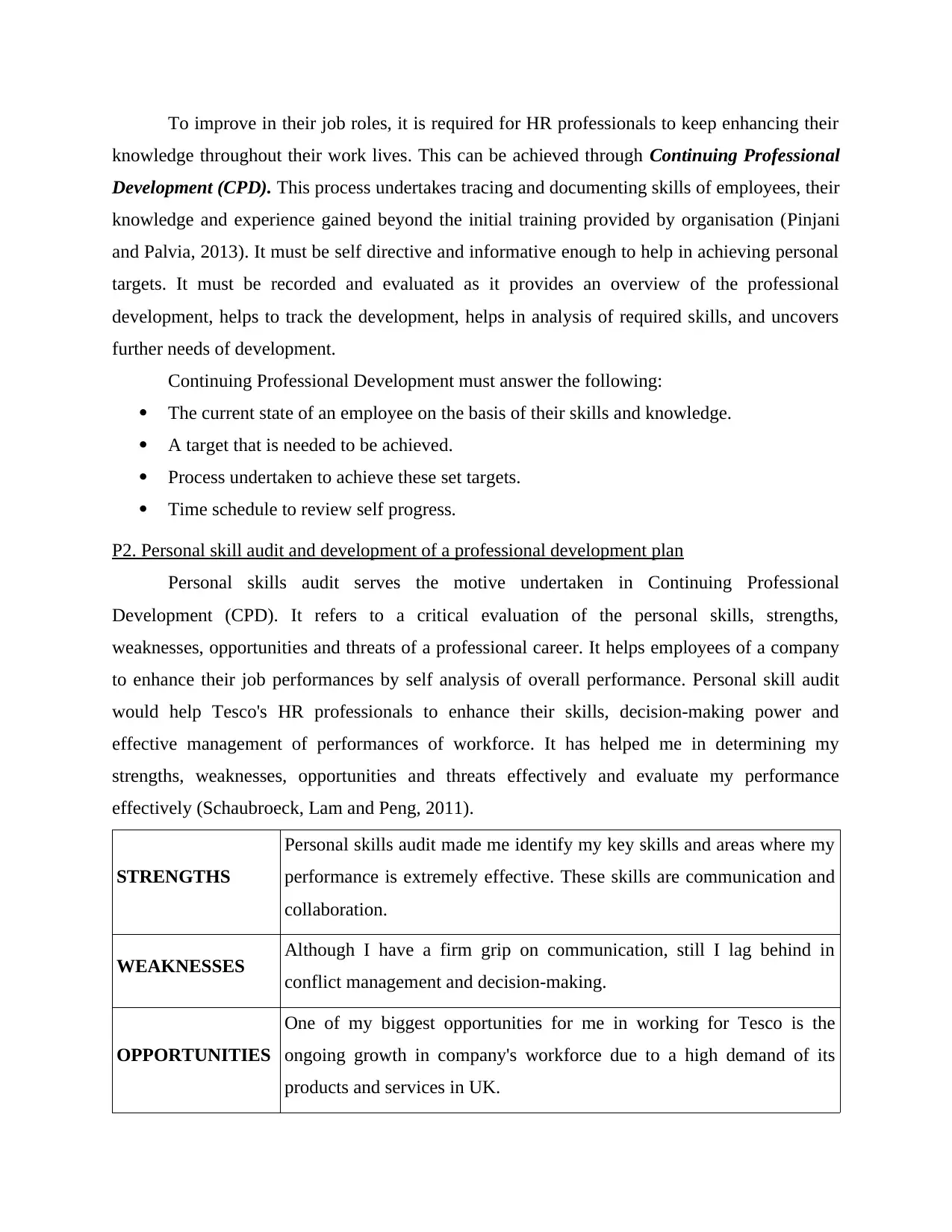
To improve in their job roles, it is required for HR professionals to keep enhancing their
knowledge throughout their work lives. This can be achieved through Continuing Professional
Development (CPD). This process undertakes tracing and documenting skills of employees, their
knowledge and experience gained beyond the initial training provided by organisation (Pinjani
and Palvia, 2013). It must be self directive and informative enough to help in achieving personal
targets. It must be recorded and evaluated as it provides an overview of the professional
development, helps to track the development, helps in analysis of required skills, and uncovers
further needs of development.
Continuing Professional Development must answer the following:
The current state of an employee on the basis of their skills and knowledge.
A target that is needed to be achieved.
Process undertaken to achieve these set targets.
Time schedule to review self progress.
P2. Personal skill audit and development of a professional development plan
Personal skills audit serves the motive undertaken in Continuing Professional
Development (CPD). It refers to a critical evaluation of the personal skills, strengths,
weaknesses, opportunities and threats of a professional career. It helps employees of a company
to enhance their job performances by self analysis of overall performance. Personal skill audit
would help Tesco's HR professionals to enhance their skills, decision-making power and
effective management of performances of workforce. It has helped me in determining my
strengths, weaknesses, opportunities and threats effectively and evaluate my performance
effectively (Schaubroeck, Lam and Peng, 2011).
STRENGTHS
Personal skills audit made me identify my key skills and areas where my
performance is extremely effective. These skills are communication and
collaboration.
WEAKNESSES Although I have a firm grip on communication, still I lag behind in
conflict management and decision-making.
OPPORTUNITIES
One of my biggest opportunities for me in working for Tesco is the
ongoing growth in company's workforce due to a high demand of its
products and services in UK.
knowledge throughout their work lives. This can be achieved through Continuing Professional
Development (CPD). This process undertakes tracing and documenting skills of employees, their
knowledge and experience gained beyond the initial training provided by organisation (Pinjani
and Palvia, 2013). It must be self directive and informative enough to help in achieving personal
targets. It must be recorded and evaluated as it provides an overview of the professional
development, helps to track the development, helps in analysis of required skills, and uncovers
further needs of development.
Continuing Professional Development must answer the following:
The current state of an employee on the basis of their skills and knowledge.
A target that is needed to be achieved.
Process undertaken to achieve these set targets.
Time schedule to review self progress.
P2. Personal skill audit and development of a professional development plan
Personal skills audit serves the motive undertaken in Continuing Professional
Development (CPD). It refers to a critical evaluation of the personal skills, strengths,
weaknesses, opportunities and threats of a professional career. It helps employees of a company
to enhance their job performances by self analysis of overall performance. Personal skill audit
would help Tesco's HR professionals to enhance their skills, decision-making power and
effective management of performances of workforce. It has helped me in determining my
strengths, weaknesses, opportunities and threats effectively and evaluate my performance
effectively (Schaubroeck, Lam and Peng, 2011).
STRENGTHS
Personal skills audit made me identify my key skills and areas where my
performance is extremely effective. These skills are communication and
collaboration.
WEAKNESSES Although I have a firm grip on communication, still I lag behind in
conflict management and decision-making.
OPPORTUNITIES
One of my biggest opportunities for me in working for Tesco is the
ongoing growth in company's workforce due to a high demand of its
products and services in UK.
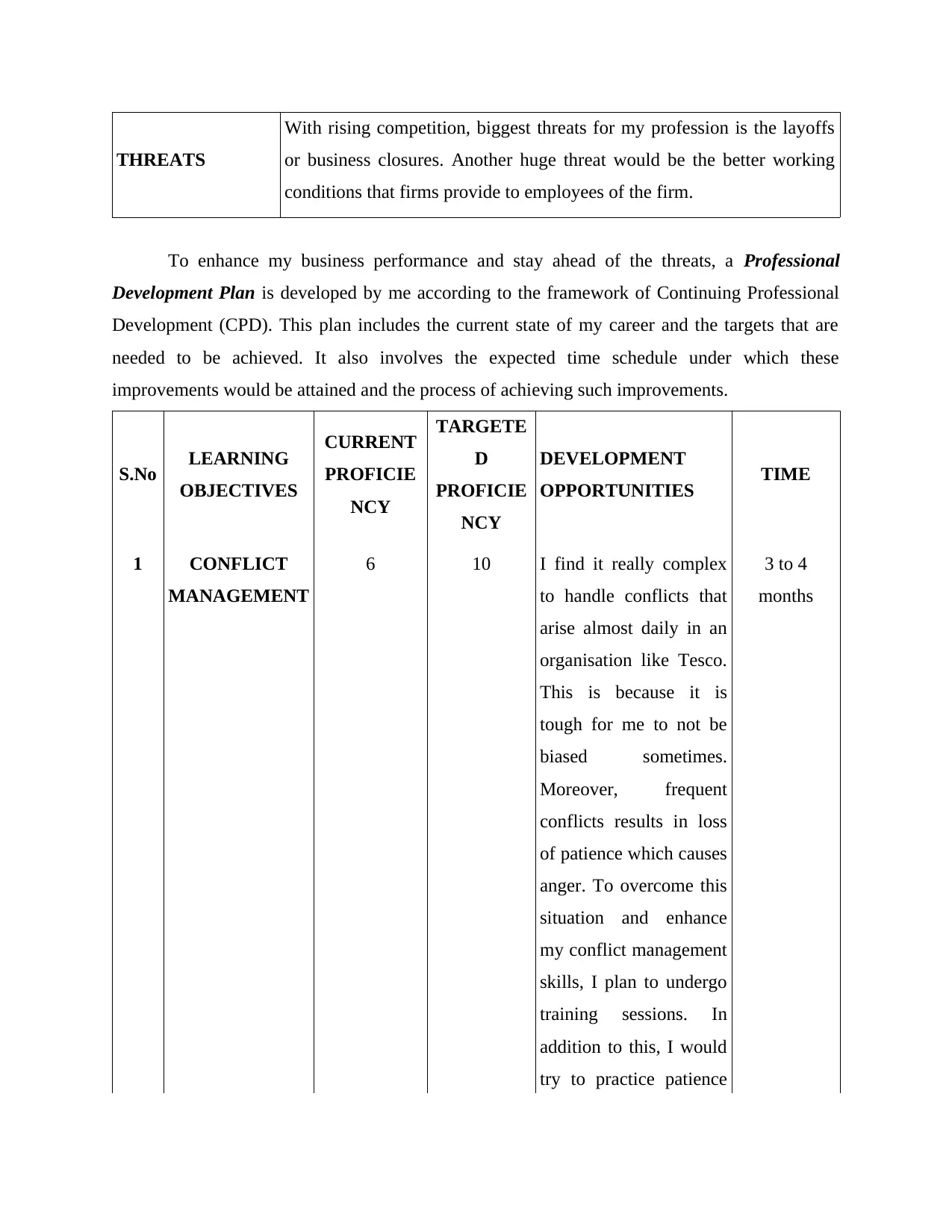
THREATS
With rising competition, biggest threats for my profession is the layoffs
or business closures. Another huge threat would be the better working
conditions that firms provide to employees of the firm.
To enhance my business performance and stay ahead of the threats, a Professional
Development Plan is developed by me according to the framework of Continuing Professional
Development (CPD). This plan includes the current state of my career and the targets that are
needed to be achieved. It also involves the expected time schedule under which these
improvements would be attained and the process of achieving such improvements.
S.No LEARNING
OBJECTIVES
CURRENT
PROFICIE
NCY
TARGETE
D
PROFICIE
NCY
DEVELOPMENT
OPPORTUNITIES TIME
1 CONFLICT
MANAGEMENT
6 10 I find it really complex
to handle conflicts that
arise almost daily in an
organisation like Tesco.
This is because it is
tough for me to not be
biased sometimes.
Moreover, frequent
conflicts results in loss
of patience which causes
anger. To overcome this
situation and enhance
my conflict management
skills, I plan to undergo
training sessions. In
addition to this, I would
try to practice patience
3 to 4
months
With rising competition, biggest threats for my profession is the layoffs
or business closures. Another huge threat would be the better working
conditions that firms provide to employees of the firm.
To enhance my business performance and stay ahead of the threats, a Professional
Development Plan is developed by me according to the framework of Continuing Professional
Development (CPD). This plan includes the current state of my career and the targets that are
needed to be achieved. It also involves the expected time schedule under which these
improvements would be attained and the process of achieving such improvements.
S.No LEARNING
OBJECTIVES
CURRENT
PROFICIE
NCY
TARGETE
D
PROFICIE
NCY
DEVELOPMENT
OPPORTUNITIES TIME
1 CONFLICT
MANAGEMENT
6 10 I find it really complex
to handle conflicts that
arise almost daily in an
organisation like Tesco.
This is because it is
tough for me to not be
biased sometimes.
Moreover, frequent
conflicts results in loss
of patience which causes
anger. To overcome this
situation and enhance
my conflict management
skills, I plan to undergo
training sessions. In
addition to this, I would
try to practice patience
3 to 4
months
⊘ This is a preview!⊘
Do you want full access?
Subscribe today to unlock all pages.

Trusted by 1+ million students worldwide
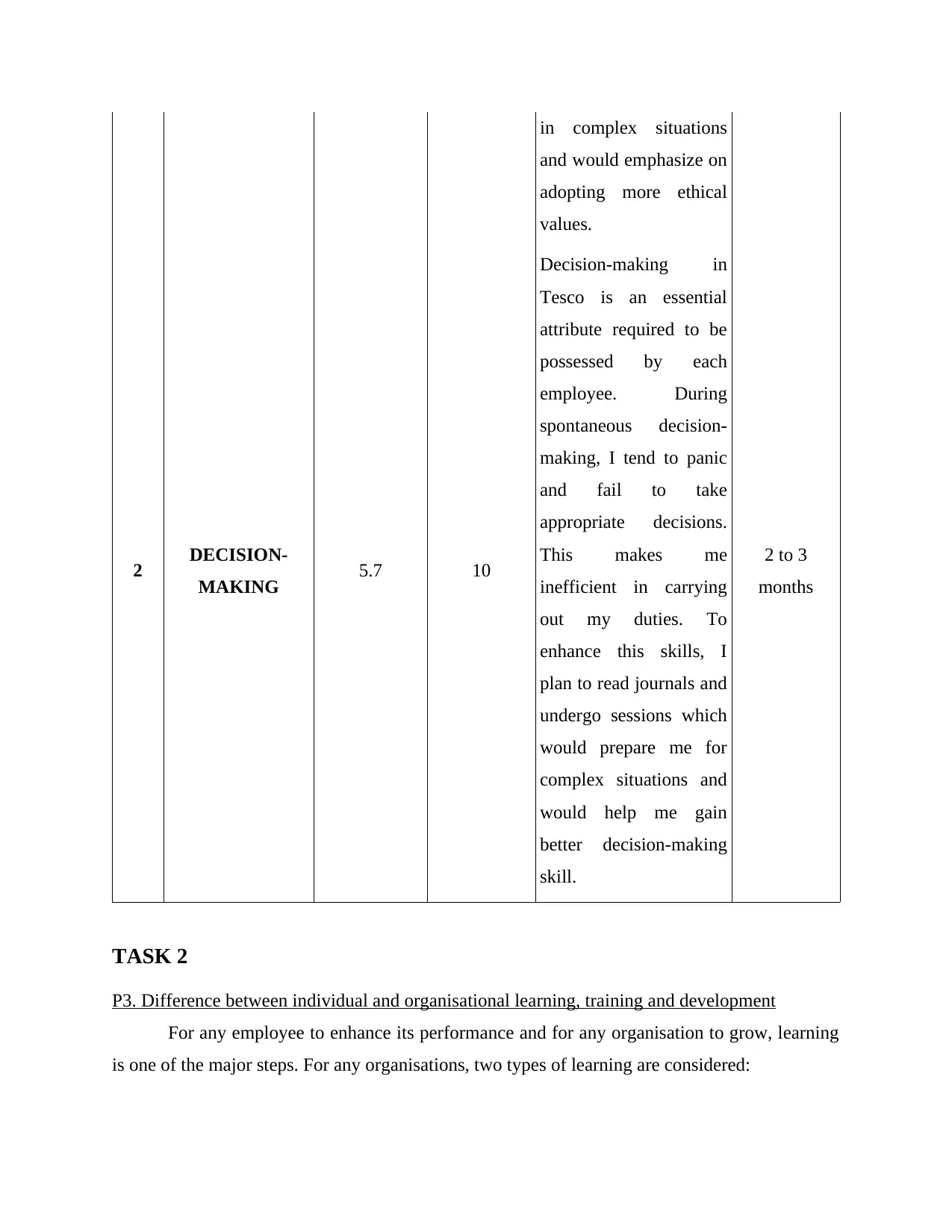
in complex situations
and would emphasize on
adopting more ethical
values.
2 DECISION-
MAKING 5.7 10
Decision-making in
Tesco is an essential
attribute required to be
possessed by each
employee. During
spontaneous decision-
making, I tend to panic
and fail to take
appropriate decisions.
This makes me
inefficient in carrying
out my duties. To
enhance this skills, I
plan to read journals and
undergo sessions which
would prepare me for
complex situations and
would help me gain
better decision-making
skill.
2 to 3
months
TASK 2
P3. Difference between individual and organisational learning, training and development
For any employee to enhance its performance and for any organisation to grow, learning
is one of the major steps. For any organisations, two types of learning are considered:
and would emphasize on
adopting more ethical
values.
2 DECISION-
MAKING 5.7 10
Decision-making in
Tesco is an essential
attribute required to be
possessed by each
employee. During
spontaneous decision-
making, I tend to panic
and fail to take
appropriate decisions.
This makes me
inefficient in carrying
out my duties. To
enhance this skills, I
plan to read journals and
undergo sessions which
would prepare me for
complex situations and
would help me gain
better decision-making
skill.
2 to 3
months
TASK 2
P3. Difference between individual and organisational learning, training and development
For any employee to enhance its performance and for any organisation to grow, learning
is one of the major steps. For any organisations, two types of learning are considered:
Paraphrase This Document
Need a fresh take? Get an instant paraphrase of this document with our AI Paraphraser
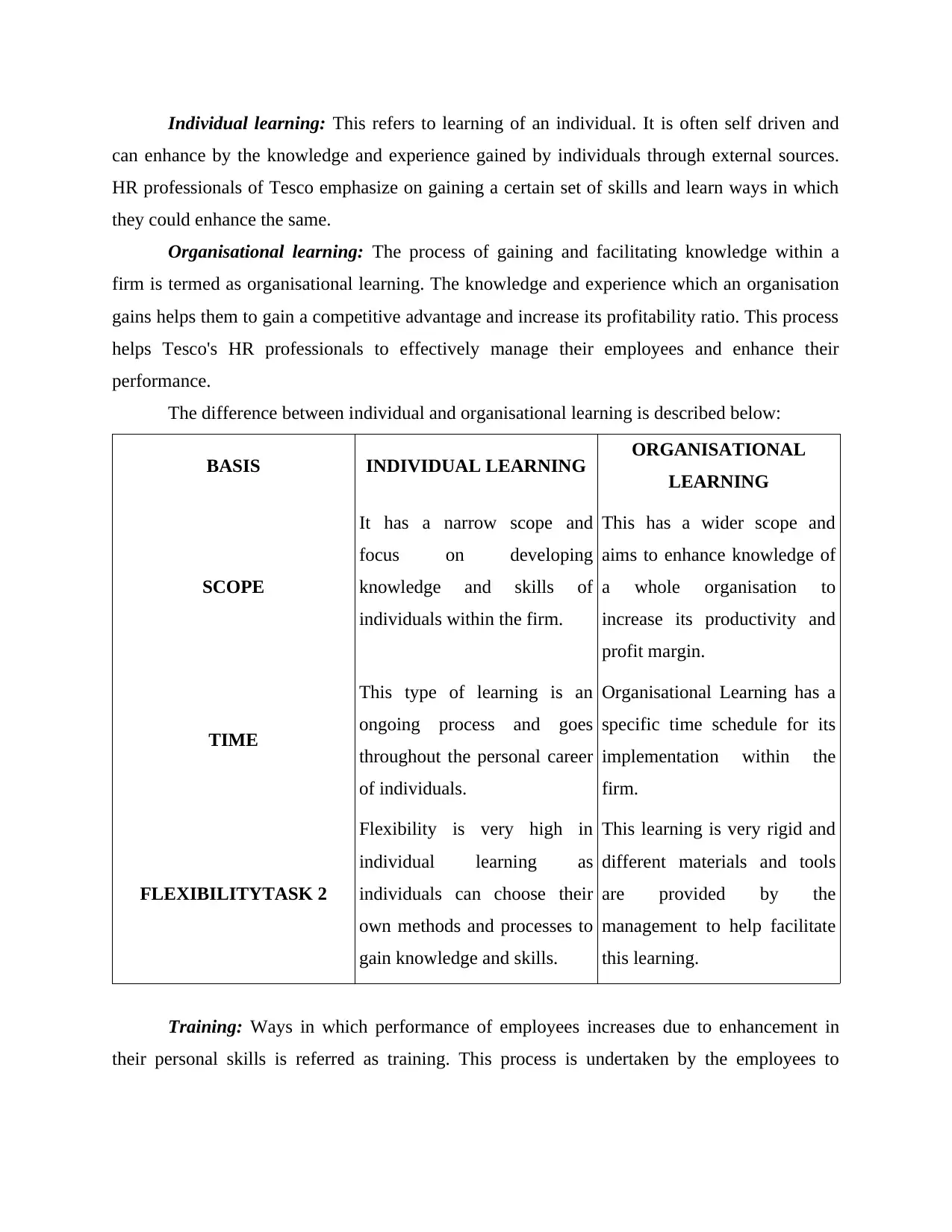
Individual learning: This refers to learning of an individual. It is often self driven and
can enhance by the knowledge and experience gained by individuals through external sources.
HR professionals of Tesco emphasize on gaining a certain set of skills and learn ways in which
they could enhance the same.
Organisational learning: The process of gaining and facilitating knowledge within a
firm is termed as organisational learning. The knowledge and experience which an organisation
gains helps them to gain a competitive advantage and increase its profitability ratio. This process
helps Tesco's HR professionals to effectively manage their employees and enhance their
performance.
The difference between individual and organisational learning is described below:
BASIS INDIVIDUAL LEARNING ORGANISATIONAL
LEARNING
SCOPE
It has a narrow scope and
focus on developing
knowledge and skills of
individuals within the firm.
This has a wider scope and
aims to enhance knowledge of
a whole organisation to
increase its productivity and
profit margin.
TIME
This type of learning is an
ongoing process and goes
throughout the personal career
of individuals.
Organisational Learning has a
specific time schedule for its
implementation within the
firm.
FLEXIBILITYTASK 2
Flexibility is very high in
individual learning as
individuals can choose their
own methods and processes to
gain knowledge and skills.
This learning is very rigid and
different materials and tools
are provided by the
management to help facilitate
this learning.
Training: Ways in which performance of employees increases due to enhancement in
their personal skills is referred as training. This process is undertaken by the employees to
can enhance by the knowledge and experience gained by individuals through external sources.
HR professionals of Tesco emphasize on gaining a certain set of skills and learn ways in which
they could enhance the same.
Organisational learning: The process of gaining and facilitating knowledge within a
firm is termed as organisational learning. The knowledge and experience which an organisation
gains helps them to gain a competitive advantage and increase its profitability ratio. This process
helps Tesco's HR professionals to effectively manage their employees and enhance their
performance.
The difference between individual and organisational learning is described below:
BASIS INDIVIDUAL LEARNING ORGANISATIONAL
LEARNING
SCOPE
It has a narrow scope and
focus on developing
knowledge and skills of
individuals within the firm.
This has a wider scope and
aims to enhance knowledge of
a whole organisation to
increase its productivity and
profit margin.
TIME
This type of learning is an
ongoing process and goes
throughout the personal career
of individuals.
Organisational Learning has a
specific time schedule for its
implementation within the
firm.
FLEXIBILITYTASK 2
Flexibility is very high in
individual learning as
individuals can choose their
own methods and processes to
gain knowledge and skills.
This learning is very rigid and
different materials and tools
are provided by the
management to help facilitate
this learning.
Training: Ways in which performance of employees increases due to enhancement in
their personal skills is referred as training. This process is undertaken by the employees to
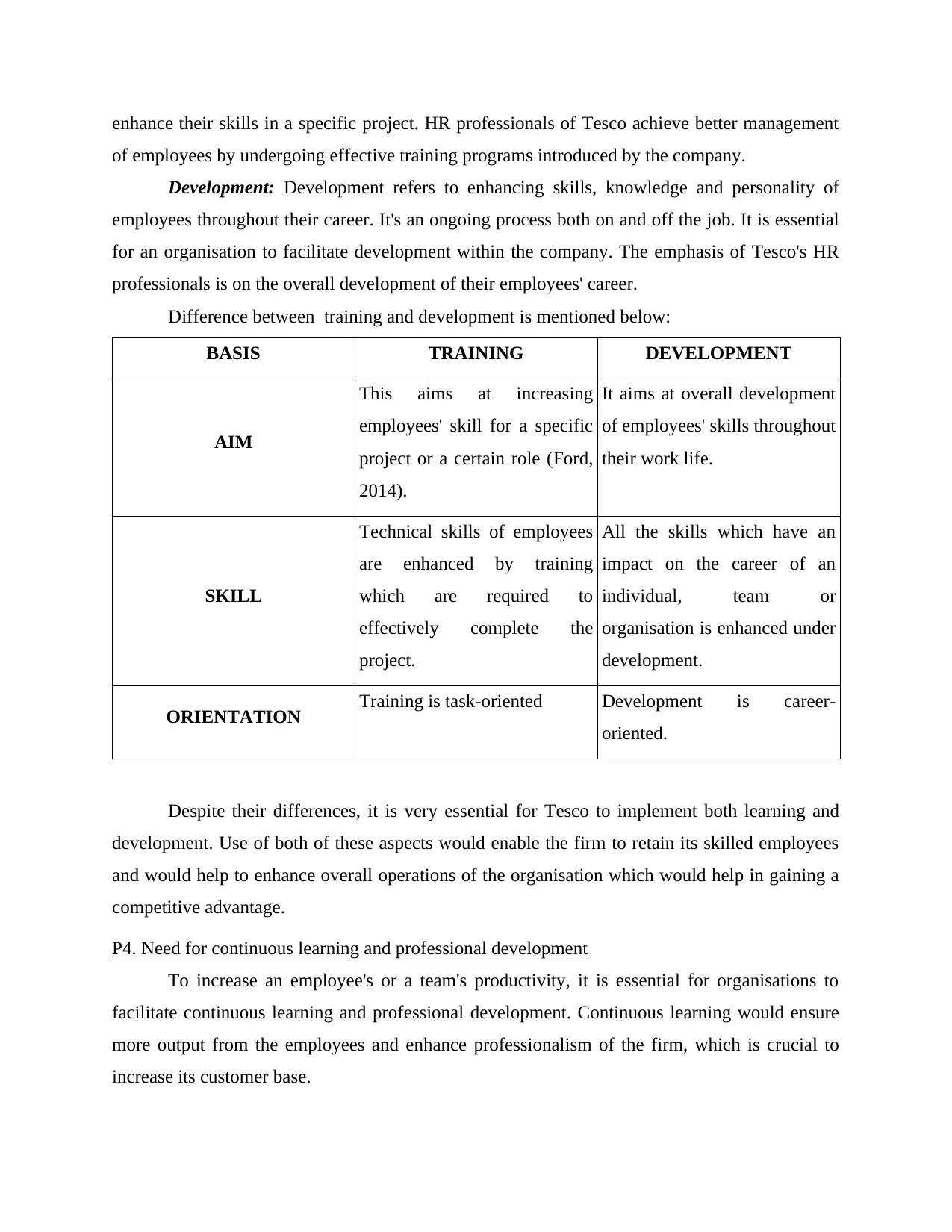
enhance their skills in a specific project. HR professionals of Tesco achieve better management
of employees by undergoing effective training programs introduced by the company.
Development: Development refers to enhancing skills, knowledge and personality of
employees throughout their career. It's an ongoing process both on and off the job. It is essential
for an organisation to facilitate development within the company. The emphasis of Tesco's HR
professionals is on the overall development of their employees' career.
Difference between training and development is mentioned below:
BASIS TRAINING DEVELOPMENT
AIM
This aims at increasing
employees' skill for a specific
project or a certain role (Ford,
2014).
It aims at overall development
of employees' skills throughout
their work life.
SKILL
Technical skills of employees
are enhanced by training
which are required to
effectively complete the
project.
All the skills which have an
impact on the career of an
individual, team or
organisation is enhanced under
development.
ORIENTATION Training is task-oriented Development is career-
oriented.
Despite their differences, it is very essential for Tesco to implement both learning and
development. Use of both of these aspects would enable the firm to retain its skilled employees
and would help to enhance overall operations of the organisation which would help in gaining a
competitive advantage.
P4. Need for continuous learning and professional development
To increase an employee's or a team's productivity, it is essential for organisations to
facilitate continuous learning and professional development. Continuous learning would ensure
more output from the employees and enhance professionalism of the firm, which is crucial to
increase its customer base.
of employees by undergoing effective training programs introduced by the company.
Development: Development refers to enhancing skills, knowledge and personality of
employees throughout their career. It's an ongoing process both on and off the job. It is essential
for an organisation to facilitate development within the company. The emphasis of Tesco's HR
professionals is on the overall development of their employees' career.
Difference between training and development is mentioned below:
BASIS TRAINING DEVELOPMENT
AIM
This aims at increasing
employees' skill for a specific
project or a certain role (Ford,
2014).
It aims at overall development
of employees' skills throughout
their work life.
SKILL
Technical skills of employees
are enhanced by training
which are required to
effectively complete the
project.
All the skills which have an
impact on the career of an
individual, team or
organisation is enhanced under
development.
ORIENTATION Training is task-oriented Development is career-
oriented.
Despite their differences, it is very essential for Tesco to implement both learning and
development. Use of both of these aspects would enable the firm to retain its skilled employees
and would help to enhance overall operations of the organisation which would help in gaining a
competitive advantage.
P4. Need for continuous learning and professional development
To increase an employee's or a team's productivity, it is essential for organisations to
facilitate continuous learning and professional development. Continuous learning would ensure
more output from the employees and enhance professionalism of the firm, which is crucial to
increase its customer base.
⊘ This is a preview!⊘
Do you want full access?
Subscribe today to unlock all pages.

Trusted by 1+ million students worldwide
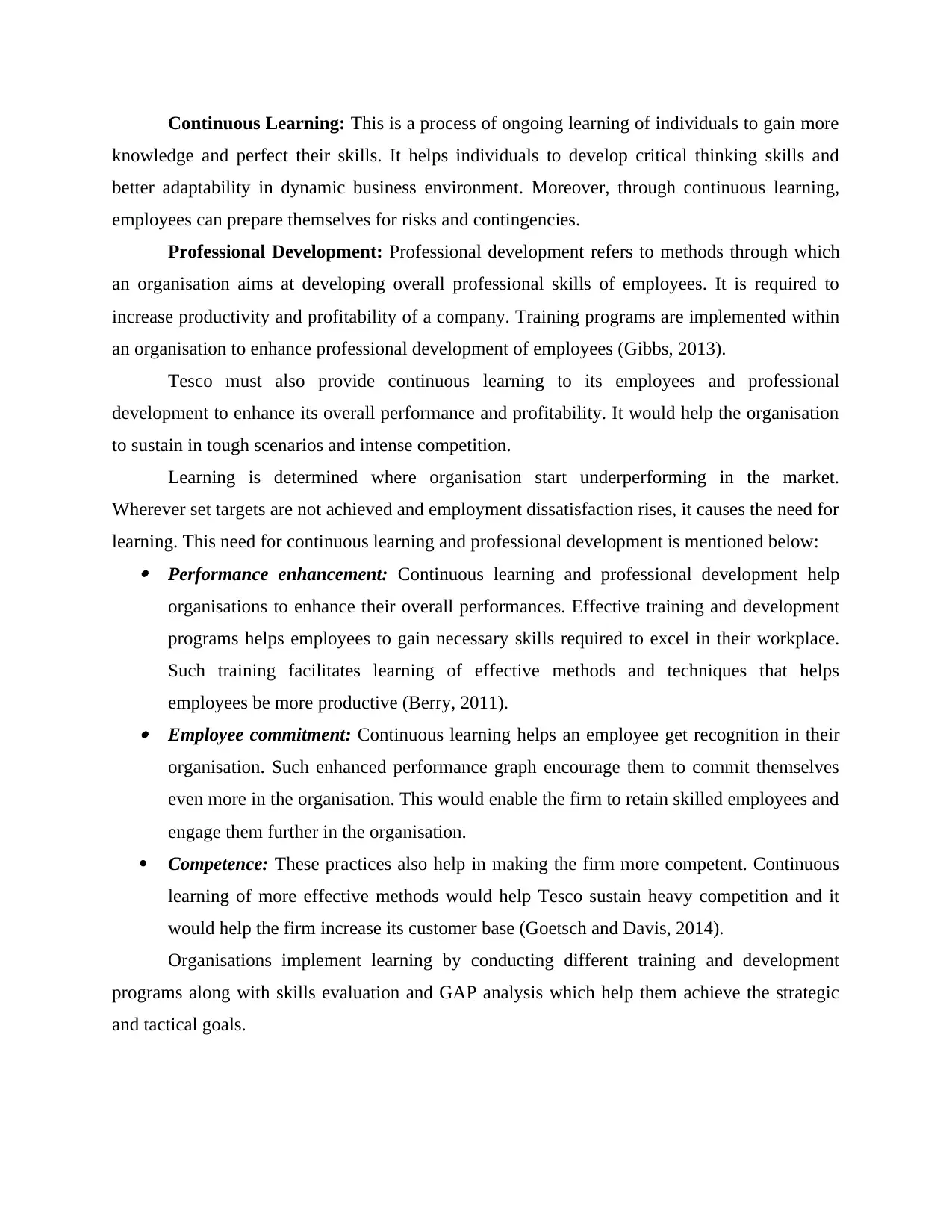
Continuous Learning: This is a process of ongoing learning of individuals to gain more
knowledge and perfect their skills. It helps individuals to develop critical thinking skills and
better adaptability in dynamic business environment. Moreover, through continuous learning,
employees can prepare themselves for risks and contingencies.
Professional Development: Professional development refers to methods through which
an organisation aims at developing overall professional skills of employees. It is required to
increase productivity and profitability of a company. Training programs are implemented within
an organisation to enhance professional development of employees (Gibbs, 2013).
Tesco must also provide continuous learning to its employees and professional
development to enhance its overall performance and profitability. It would help the organisation
to sustain in tough scenarios and intense competition.
Learning is determined where organisation start underperforming in the market.
Wherever set targets are not achieved and employment dissatisfaction rises, it causes the need for
learning. This need for continuous learning and professional development is mentioned below: Performance enhancement: Continuous learning and professional development help
organisations to enhance their overall performances. Effective training and development
programs helps employees to gain necessary skills required to excel in their workplace.
Such training facilitates learning of effective methods and techniques that helps
employees be more productive (Berry, 2011). Employee commitment: Continuous learning helps an employee get recognition in their
organisation. Such enhanced performance graph encourage them to commit themselves
even more in the organisation. This would enable the firm to retain skilled employees and
engage them further in the organisation.
Competence: These practices also help in making the firm more competent. Continuous
learning of more effective methods would help Tesco sustain heavy competition and it
would help the firm increase its customer base (Goetsch and Davis, 2014).
Organisations implement learning by conducting different training and development
programs along with skills evaluation and GAP analysis which help them achieve the strategic
and tactical goals.
knowledge and perfect their skills. It helps individuals to develop critical thinking skills and
better adaptability in dynamic business environment. Moreover, through continuous learning,
employees can prepare themselves for risks and contingencies.
Professional Development: Professional development refers to methods through which
an organisation aims at developing overall professional skills of employees. It is required to
increase productivity and profitability of a company. Training programs are implemented within
an organisation to enhance professional development of employees (Gibbs, 2013).
Tesco must also provide continuous learning to its employees and professional
development to enhance its overall performance and profitability. It would help the organisation
to sustain in tough scenarios and intense competition.
Learning is determined where organisation start underperforming in the market.
Wherever set targets are not achieved and employment dissatisfaction rises, it causes the need for
learning. This need for continuous learning and professional development is mentioned below: Performance enhancement: Continuous learning and professional development help
organisations to enhance their overall performances. Effective training and development
programs helps employees to gain necessary skills required to excel in their workplace.
Such training facilitates learning of effective methods and techniques that helps
employees be more productive (Berry, 2011). Employee commitment: Continuous learning helps an employee get recognition in their
organisation. Such enhanced performance graph encourage them to commit themselves
even more in the organisation. This would enable the firm to retain skilled employees and
engage them further in the organisation.
Competence: These practices also help in making the firm more competent. Continuous
learning of more effective methods would help Tesco sustain heavy competition and it
would help the firm increase its customer base (Goetsch and Davis, 2014).
Organisations implement learning by conducting different training and development
programs along with skills evaluation and GAP analysis which help them achieve the strategic
and tactical goals.
Paraphrase This Document
Need a fresh take? Get an instant paraphrase of this document with our AI Paraphraser
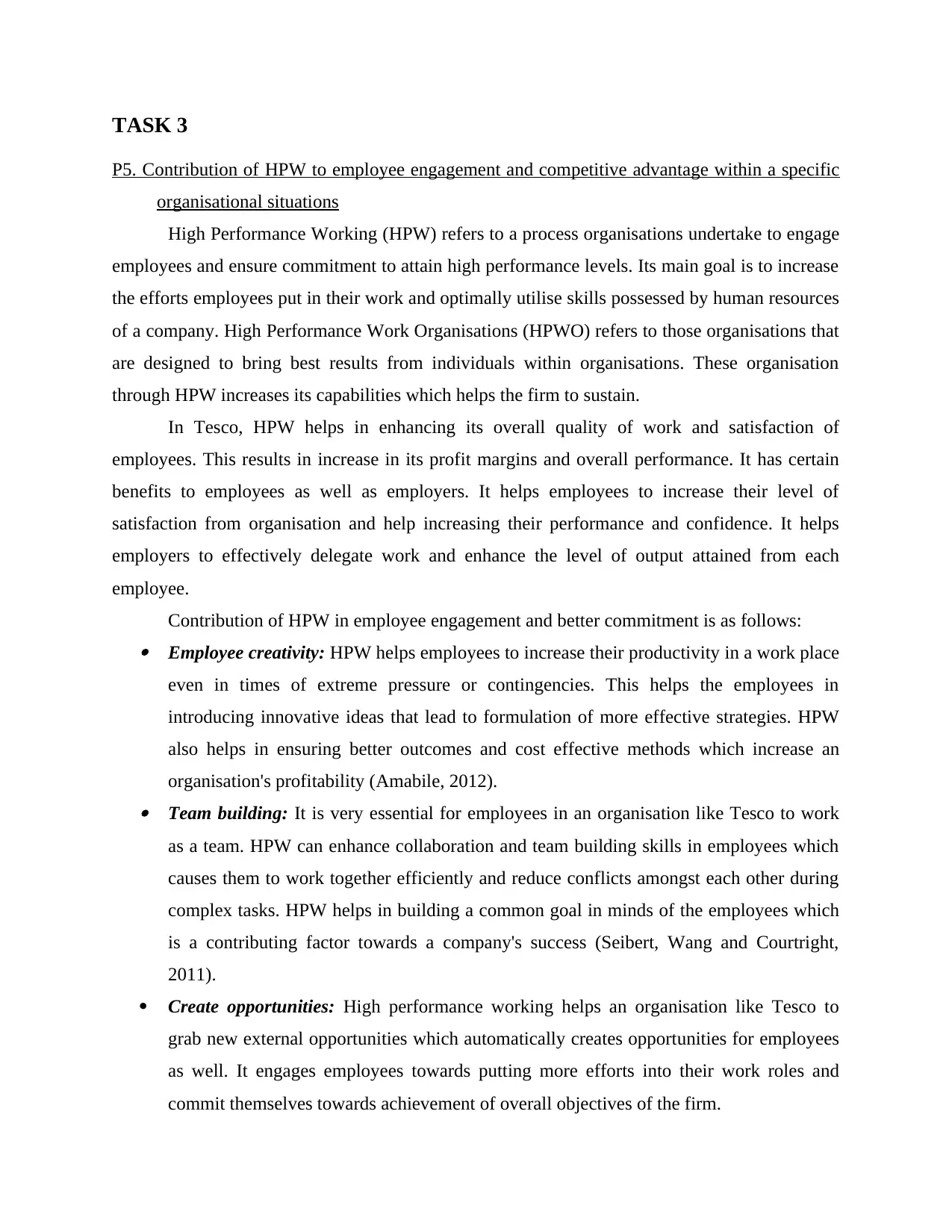
TASK 3
P5. Contribution of HPW to employee engagement and competitive advantage within a specific
organisational situations
High Performance Working (HPW) refers to a process organisations undertake to engage
employees and ensure commitment to attain high performance levels. Its main goal is to increase
the efforts employees put in their work and optimally utilise skills possessed by human resources
of a company. High Performance Work Organisations (HPWO) refers to those organisations that
are designed to bring best results from individuals within organisations. These organisation
through HPW increases its capabilities which helps the firm to sustain.
In Tesco, HPW helps in enhancing its overall quality of work and satisfaction of
employees. This results in increase in its profit margins and overall performance. It has certain
benefits to employees as well as employers. It helps employees to increase their level of
satisfaction from organisation and help increasing their performance and confidence. It helps
employers to effectively delegate work and enhance the level of output attained from each
employee.
Contribution of HPW in employee engagement and better commitment is as follows: Employee creativity: HPW helps employees to increase their productivity in a work place
even in times of extreme pressure or contingencies. This helps the employees in
introducing innovative ideas that lead to formulation of more effective strategies. HPW
also helps in ensuring better outcomes and cost effective methods which increase an
organisation's profitability (Amabile, 2012). Team building: It is very essential for employees in an organisation like Tesco to work
as a team. HPW can enhance collaboration and team building skills in employees which
causes them to work together efficiently and reduce conflicts amongst each other during
complex tasks. HPW helps in building a common goal in minds of the employees which
is a contributing factor towards a company's success (Seibert, Wang and Courtright,
2011).
Create opportunities: High performance working helps an organisation like Tesco to
grab new external opportunities which automatically creates opportunities for employees
as well. It engages employees towards putting more efforts into their work roles and
commit themselves towards achievement of overall objectives of the firm.
P5. Contribution of HPW to employee engagement and competitive advantage within a specific
organisational situations
High Performance Working (HPW) refers to a process organisations undertake to engage
employees and ensure commitment to attain high performance levels. Its main goal is to increase
the efforts employees put in their work and optimally utilise skills possessed by human resources
of a company. High Performance Work Organisations (HPWO) refers to those organisations that
are designed to bring best results from individuals within organisations. These organisation
through HPW increases its capabilities which helps the firm to sustain.
In Tesco, HPW helps in enhancing its overall quality of work and satisfaction of
employees. This results in increase in its profit margins and overall performance. It has certain
benefits to employees as well as employers. It helps employees to increase their level of
satisfaction from organisation and help increasing their performance and confidence. It helps
employers to effectively delegate work and enhance the level of output attained from each
employee.
Contribution of HPW in employee engagement and better commitment is as follows: Employee creativity: HPW helps employees to increase their productivity in a work place
even in times of extreme pressure or contingencies. This helps the employees in
introducing innovative ideas that lead to formulation of more effective strategies. HPW
also helps in ensuring better outcomes and cost effective methods which increase an
organisation's profitability (Amabile, 2012). Team building: It is very essential for employees in an organisation like Tesco to work
as a team. HPW can enhance collaboration and team building skills in employees which
causes them to work together efficiently and reduce conflicts amongst each other during
complex tasks. HPW helps in building a common goal in minds of the employees which
is a contributing factor towards a company's success (Seibert, Wang and Courtright,
2011).
Create opportunities: High performance working helps an organisation like Tesco to
grab new external opportunities which automatically creates opportunities for employees
as well. It engages employees towards putting more efforts into their work roles and
commit themselves towards achievement of overall objectives of the firm.
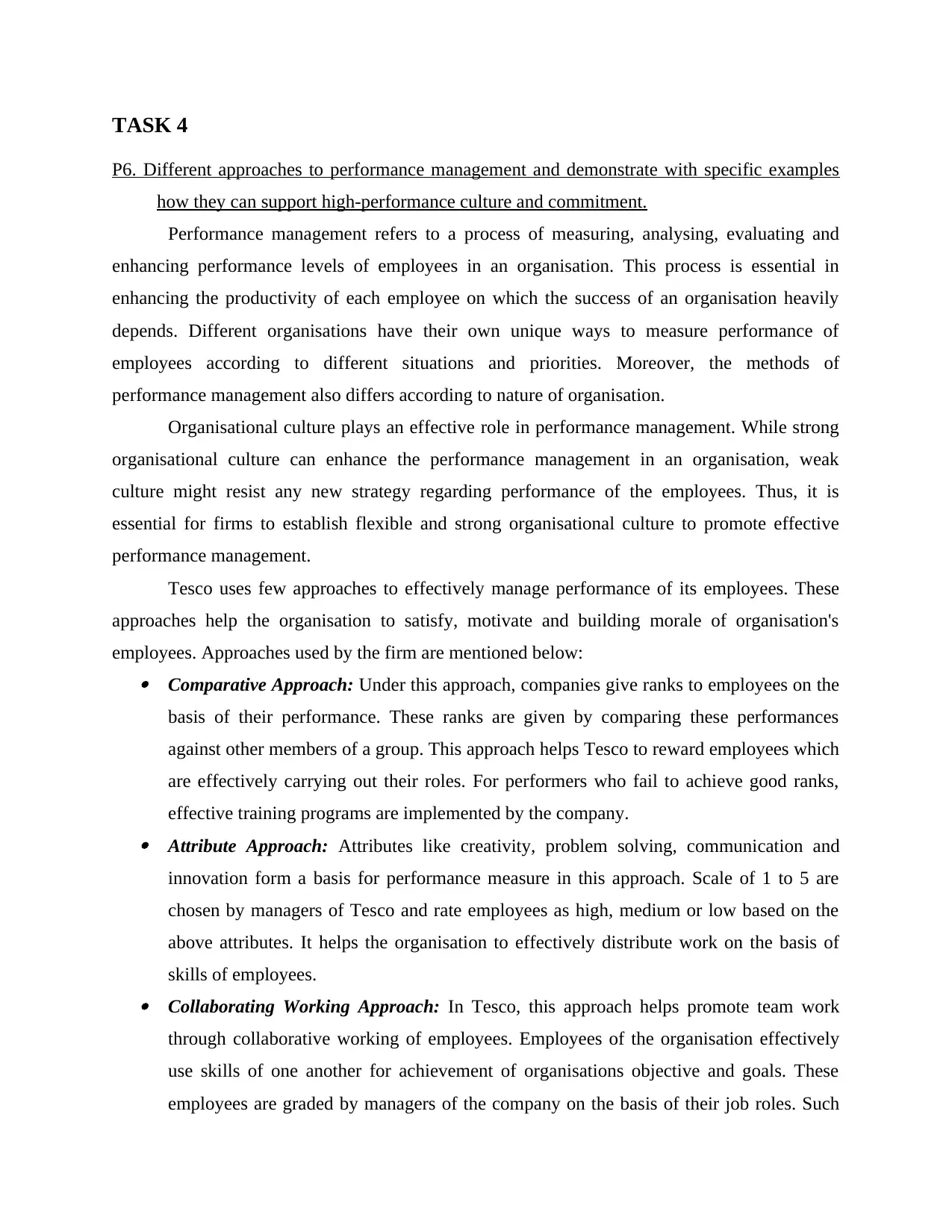
TASK 4
P6. Different approaches to performance management and demonstrate with specific examples
how they can support high-performance culture and commitment.
Performance management refers to a process of measuring, analysing, evaluating and
enhancing performance levels of employees in an organisation. This process is essential in
enhancing the productivity of each employee on which the success of an organisation heavily
depends. Different organisations have their own unique ways to measure performance of
employees according to different situations and priorities. Moreover, the methods of
performance management also differs according to nature of organisation.
Organisational culture plays an effective role in performance management. While strong
organisational culture can enhance the performance management in an organisation, weak
culture might resist any new strategy regarding performance of the employees. Thus, it is
essential for firms to establish flexible and strong organisational culture to promote effective
performance management.
Tesco uses few approaches to effectively manage performance of its employees. These
approaches help the organisation to satisfy, motivate and building morale of organisation's
employees. Approaches used by the firm are mentioned below: Comparative Approach: Under this approach, companies give ranks to employees on the
basis of their performance. These ranks are given by comparing these performances
against other members of a group. This approach helps Tesco to reward employees which
are effectively carrying out their roles. For performers who fail to achieve good ranks,
effective training programs are implemented by the company. Attribute Approach: Attributes like creativity, problem solving, communication and
innovation form a basis for performance measure in this approach. Scale of 1 to 5 are
chosen by managers of Tesco and rate employees as high, medium or low based on the
above attributes. It helps the organisation to effectively distribute work on the basis of
skills of employees. Collaborating Working Approach: In Tesco, this approach helps promote team work
through collaborative working of employees. Employees of the organisation effectively
use skills of one another for achievement of organisations objective and goals. These
employees are graded by managers of the company on the basis of their job roles. Such
P6. Different approaches to performance management and demonstrate with specific examples
how they can support high-performance culture and commitment.
Performance management refers to a process of measuring, analysing, evaluating and
enhancing performance levels of employees in an organisation. This process is essential in
enhancing the productivity of each employee on which the success of an organisation heavily
depends. Different organisations have their own unique ways to measure performance of
employees according to different situations and priorities. Moreover, the methods of
performance management also differs according to nature of organisation.
Organisational culture plays an effective role in performance management. While strong
organisational culture can enhance the performance management in an organisation, weak
culture might resist any new strategy regarding performance of the employees. Thus, it is
essential for firms to establish flexible and strong organisational culture to promote effective
performance management.
Tesco uses few approaches to effectively manage performance of its employees. These
approaches help the organisation to satisfy, motivate and building morale of organisation's
employees. Approaches used by the firm are mentioned below: Comparative Approach: Under this approach, companies give ranks to employees on the
basis of their performance. These ranks are given by comparing these performances
against other members of a group. This approach helps Tesco to reward employees which
are effectively carrying out their roles. For performers who fail to achieve good ranks,
effective training programs are implemented by the company. Attribute Approach: Attributes like creativity, problem solving, communication and
innovation form a basis for performance measure in this approach. Scale of 1 to 5 are
chosen by managers of Tesco and rate employees as high, medium or low based on the
above attributes. It helps the organisation to effectively distribute work on the basis of
skills of employees. Collaborating Working Approach: In Tesco, this approach helps promote team work
through collaborative working of employees. Employees of the organisation effectively
use skills of one another for achievement of organisations objective and goals. These
employees are graded by managers of the company on the basis of their job roles. Such
⊘ This is a preview!⊘
Do you want full access?
Subscribe today to unlock all pages.

Trusted by 1+ million students worldwide
1 out of 14
Related Documents
Your All-in-One AI-Powered Toolkit for Academic Success.
+13062052269
info@desklib.com
Available 24*7 on WhatsApp / Email
![[object Object]](/_next/static/media/star-bottom.7253800d.svg)
Unlock your academic potential
Copyright © 2020–2025 A2Z Services. All Rights Reserved. Developed and managed by ZUCOL.



